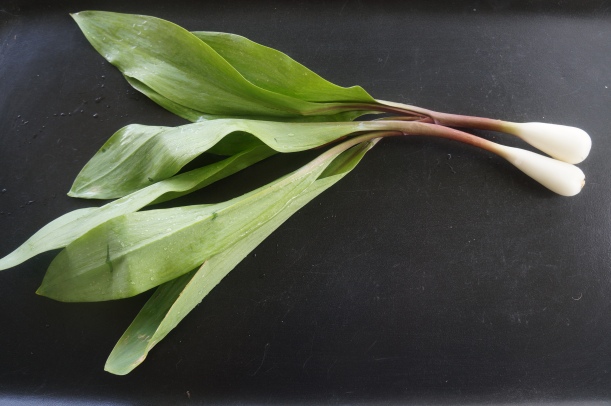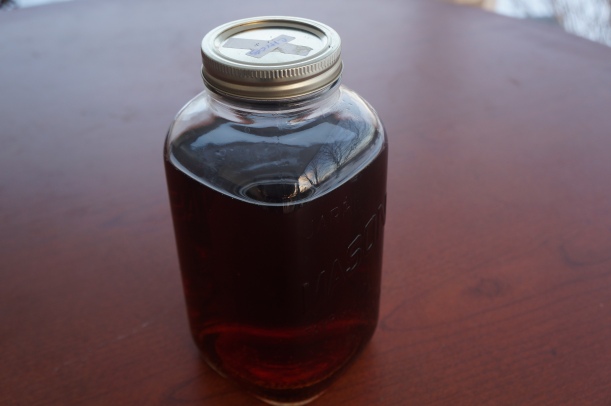If you are one who enjoys grilled game, fish or fowl, this aromatic jelly is for you. And if you’re not one to consume any of those, you will still enjoy this with cheese and bagels, or simply on toasted sourdough bread. Either way it is a perfect condiment for any larder.
Even knowing that cedar is one of the many flavourful and scented evergreens native to this region, I have hesitated to use it up till now. It contains a chemical called thuja which should not be consumed in large quantities, and definitely should be avoided by pregnant and nursing women. Recently I watched a cooking show about pre-colonial recipes, and noticed they used a cedar jelly as an accompaniment to game, so I figured that the quantities of thuja in this had to be tolerable. On further researching, I discovered that there are several greens which contain this chemical, most notably juniper, some mints and sage, all of which are found in most cooks’ pantries. I also learned that early settlers used the leaves to make tea to prevent scurvy, and many campers continue to use it as an available source for a tasty drink. I therefore concluded that making a cedar jelly recipe to be consumed occasionally in small amounts would be delicious and safe, as long as you are not pregnant or nursing.
The cedar tree I am referring to is one that is commonly found in the north eastern parts of North America – the eastern white cedar. There is a similar western version, but I am only familiar with the one from this zone. It is a fast growing, hardy conifer favoured in landscaping but also easy to find in the wild. Its small scaly leaves cover the fan-shaped twigs and vary from yellowish to deep green. Its small cones grow in clumps of five or six pairs.
 Three things to note about cooking with these leaves are:
Three things to note about cooking with these leaves are:
keep the simmering or steeping mixture covered to prevent the volatile oils from escaping;
use only the lighter green tips growing from sill-green branches;
the longer the cooking process, the more flavour will be lost.
So bearing these in mind, here is the recipe I came up with.
Cedar Jelly
Ingredients
2 cups cedar leaves
2 cups water
2 cups sugar
juice of 1 lemon
1 pkg (85 ml) liquid pectin
Method
Place the leaves and water in a jar and press the leaves down to submerge. Cover with a lid and set in the sun for at least four hours. This will extract a good amount of flavour without cooking it.
Strain the liquid, add the sugar, lemon and pectin. Bring to a boil and simmer for about 10 minutes, until foam forms on the top. Skim off the foam and bottle.
To date, I have no way of measuring the ph level for purposes of canning, so I am just freezing as my method of storing. This recipe makes three 8 oz jars.

Linked to: Fiesta Friday #184; Food Eat Love; The Not So Creative Cook.





 The nutritional value of the dandelion is becoming increasingly understood, yet the number of appetizing ways to use the plant are still rare. While the flowers are not the richest source of nutrients compared to the roots and leaves, they do contain some health benefits, including antioxidants and vitamins A and B12. For more about the flower as a food source,
The nutritional value of the dandelion is becoming increasingly understood, yet the number of appetizing ways to use the plant are still rare. While the flowers are not the richest source of nutrients compared to the roots and leaves, they do contain some health benefits, including antioxidants and vitamins A and B12. For more about the flower as a food source, 

 I only discovered the honeysuckle growing on our property a couple of years ago, and this year the number of bushes seems to have multiplied. I don’t really believe that is possible – probably I just am able to distinguish them more easily from the masses of lilacs that bloom around the same time because now I know they’re there. In fact, I have spotted honeysuckle regularly on the road, most of the way between here in E. Ontario and New York City, so I know our garden is no exception.
I only discovered the honeysuckle growing on our property a couple of years ago, and this year the number of bushes seems to have multiplied. I don’t really believe that is possible – probably I just am able to distinguish them more easily from the masses of lilacs that bloom around the same time because now I know they’re there. In fact, I have spotted honeysuckle regularly on the road, most of the way between here in E. Ontario and New York City, so I know our garden is no exception.

 This is turning out to be a great year for ramps (aka wild leeks or wild garlic). The cool weather has prolonged the season and I had the good fortune to have access to a bonanza of this seasonal delicacy on the property of a kind and gracious friend. If you don’t have access to them, you are likely to find them at good markets in any area where they are grown. For information on how to identify and pick them refer to this
This is turning out to be a great year for ramps (aka wild leeks or wild garlic). The cool weather has prolonged the season and I had the good fortune to have access to a bonanza of this seasonal delicacy on the property of a kind and gracious friend. If you don’t have access to them, you are likely to find them at good markets in any area where they are grown. For information on how to identify and pick them refer to this 






 Until recently, bitters were just something I kept in the liquor cabinet for the odd occasion when a cocktail was called for. Since my lone bottle was not getting a lot of attention, I started to add it to some savoury recipes for a little extra zing. Without really understanding what bitters were, my ideas for its uses were somewhat limited.
Until recently, bitters were just something I kept in the liquor cabinet for the odd occasion when a cocktail was called for. Since my lone bottle was not getting a lot of attention, I started to add it to some savoury recipes for a little extra zing. Without really understanding what bitters were, my ideas for its uses were somewhat limited.


 I have written several posts on
I have written several posts on 

 Perhaps my favourite way of using the liquid is by making
Perhaps my favourite way of using the liquid is by making 





